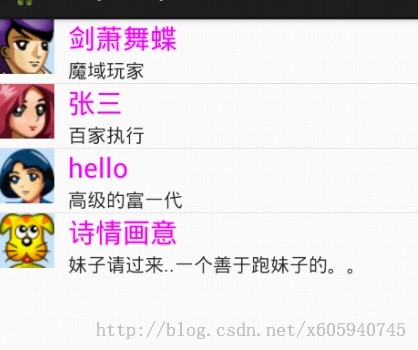
- Android中的Handler与多线程应用实例
- Android技巧一之启动屏+新功能左右导航逻辑
- Android安卓中循环录像并检测内存卡容量
- Android中 webView调用JS出错的解决办法
- Android绘制炫酷引导界面
- Android应用中使用ViewPager实现类似QQ的界面切换效果
- Android仿QQ好友列表实现列表收缩与展开
- Android应用中加入微信分享简单方法
- android中把文件保存到sdcard代码实例
- android 使用uinput模拟输入设备的方法
- Android 自定义对话框 showSetPwdDialog
- 详解Android中AsyncTask机制
- Android判断设备网络连接状态及判断连接方式的方法
- Android天气预报app改进版
- Android开发教程之调用摄像头功能的方法详解
- Android使用VideoView播放本地视频和网络视频的方法
- Android编程开发之TextView单击链接弹出Activity的方法
- 详解Android中Handler的内部实现原理
- Android Mms之:草稿管理的应用
- [Android开发从零开始].18.消息处理详解
- 浅谈AnDroidDraw+DroidDraw实现Android程序UI设计的分析说明
- Android客户端软件开发_14、多线程断点续传之监听器
- android 电话状态监听(来电和去电)实现代码
- android解析JSON数据
- Android-App增量更新的使用姿势
- Android游戏开发实践之人物移动地图的平滑滚动处理
- Android学习之Intent中显示意图和隐式意图的用法实例分析
- Android 关于“NetworkOnMainThreadException”问题的原因分析及解决办法
- Android自定义组件ListPopWindow
- Android实现完整游戏循环的方法
举例讲解Android应用中SimpleAdapter简单适配器的使用
SimpleAdapter,跟名字一样,一个简单的适配器,既为简单,就只是被设计来做简单的应用的,比如静态数据的绑定,不过仍然有自定义的空间,比如说在每一个ListItem中加一个按钮并添加响应事件.首先还是先看一下SimpleAdapter的定义吧,直接翻译下SDK doc 吧:
这是一个简单的适配器,可以将静态数据映射到XML文件中定义好的视图。你可以指定由Map组成的List(比如ArrayList)类型的数据。在ArrayList中的每个条目对应List中的一行。Maps包含每一行的数据。你可以指定一个XML布局以指定每一行的视图,根据Map中的数据映射关键字到指定的视图。绑定数据到视图分两个阶段,首先,如果设置了SimpleAdapter.ViewBinder,那么这个设置的ViewBinder的setViewValue(android.view.View, Object, String)将被调用。如果setViewValue的返回值是true,则表示绑定已经完成,将不再调用系统默认的绑定实现。如果返回值为false,视图将按以下顺序绑定数据:
如果View实现了Checkable(例如CheckBox),期望绑定值是一个布尔类型。
TextView.期望绑定值是一个字符串类型,通过调用setViewText(TextView, String)绑定。
ImageView,期望绑定值是一个资源id或者一个字符串,通过调用setViewImage(ImageView, int) 或 setViewImage(ImageView, String)绑定数据。
如果没有一个合适的绑定发生将会抛出IllegalStateException。
先看一下构造函数:
复制代码 代码如下:
public SimpleAdapter (Context context, List<? extends Map<String, ?>> data, int resource, String[] from, int[] to)
SimpleAdapter基本上认知了其参数含义 用起来就简单多了。
SimpleAdapter的参数说明:
- 第一个参数 表示访问整个android应用程序接口,基本上所有的组件都需要
- 第二个参数表示生成一个Map(String ,Object)列表选项
- 第三个参数表示界面布局的id 表示该文件作为列表项的组件
- 第四个参数表示该Map对象的哪些key对应value来生成列表项
- 第五个参数表示来填充的组件 Map对象key对应的资源一依次填充组件 顺序有对应关系
- 注意的是map对象可以key可以找不到 但组件的必须要有资源填充 因为 找不到key也会返回null 其实就相当于给了一个null资源
下面的程序中如果 new String[] { "name", "head", "desc","name" } new int[] {R.id.name,R.id.head,R.id.desc,R.id.head}
这个head的组件会被name资源覆盖
示例代码
<LinearLayout xmlns:android="http://schemas.android.com/apk/res/android"
xmlns:tools="http://schemas.android.com/tools"
android:layout_width="match_parent"
android:layout_height="match_parent"
android:orientation="horizontal"
tools:context=".MainActivity" >
<ListView
android:id="@+id/lt1"
android:layout_width="match_parent"
android:layout_height="wrap_content" >
</ListView>
</LinearLayout>
<?xml version="1.0" encoding="utf-8"?>
<LinearLayout xmlns:android="http://schemas.android.com/apk/res/android"
android:layout_width="match_parent"
android:layout_height="match_parent"
android:orientation="horizontal" >
<ImageView
android:id="@+id/head"
android:layout_width="wrap_content"
android:layout_height="wrap_content"
android:paddingLeft="10dp" />
<LinearLayout
android:layout_width="match_parent"
android:layout_height="wrap_content"
android:orientation="vertical" >
<TextView
android:id="@+id/name"
android:layout_width="wrap_content"
android:layout_height="wrap_content"
android:textSize="20dp"
android:textColor="#f0f"
android:paddingLeft="10dp"/>
<TextView
android:id="@+id/desc"
android:layout_width="wrap_content"
android:layout_height="wrap_content"
android:textSize="14dp"
android:paddingLeft="10dp"/>
</LinearLayout>
</LinearLayout>
package com.example.simpleadptertest;
import java.util.ArrayList;
import java.util.HashMap;
import java.util.List;
import java.util.Map;
import android.app.Activity;
import android.os.Bundle;
import android.view.Menu;
import android.widget.ListView;
import android.widget.SimpleAdapter;
public class MainActivity extends Activity {
private String[] name = { "剑萧舞蝶", "张三", "hello", "诗情画意" };
private String[] desc = { "魔域玩家", "百家执行", "高级的富一代", "妹子请过来..一个善于跑妹子的。。" };
private int[] imageids = { R.drawable.libai, R.drawable.nongyu,
R.drawable.qingzhao, R.drawable.tiger };
private ListView lt1;
@Override
protected void onCreate(Bundle savedInstanceState) {
super.onCreate(savedInstanceState);
setContentView(R.layout.activity_main);
List<Map<String, Object>> listems = new ArrayList<Map<String, Object>>();
for (int i = 0; i < name.length; i++) {
Map<String, Object> listem = new HashMap<String, Object>();
listem.put("head", imageids[i]);
listem.put("name", name[i]);
listem.put("desc", desc[i]);
listems.add(listem);
}
/*SimpleAdapter的参数说明
* 第一个参数 表示访问整个android应用程序接口,基本上所有的组件都需要
* 第二个参数表示生成一个Map(String ,Object)列表选项
* 第三个参数表示界面布局的id 表示该文件作为列表项的组件
* 第四个参数表示该Map对象的哪些key对应value来生成列表项
* 第五个参数表示来填充的组件 Map对象key对应的资源一依次填充组件 顺序有对应关系
* 注意的是map对象可以key可以找不到 但组件的必须要有资源填充 因为 找不到key也会返回null 其实就相当于给了一个null资源
* 下面的程序中如果 new String[] { "name", "head", "desc","name" } new int[] {R.id.name,R.id.head,R.id.desc,R.id.head}
* 这个head的组件会被name资源覆盖
* */
SimpleAdapter simplead = new SimpleAdapter(this, listems,
R.layout.simple_item, new String[] { "name", "head", "desc" },
new int[] {R.id.name,R.id.head,R.id.desc});
lt1=(ListView)findViewById(R.id.lt1);
lt1.setAdapter(simplead);
}
@Override
public boolean onCreateOptionsMenu(Menu menu) {
// Inflate the menu; this adds items to the action bar if it is present.
getMenuInflater().inflate(R.menu.main, menu);
return true;
}
}

- Android通过SOCKET下载文件的方法
- Android 带进度条的WebView 示例代码
- Android控件之RatingBar自定义星级评分样式
- Android AutoCompleteTextView自动提示文本
- 属于自己的Android对话框(Dialog)自定义集合
- Android ScrollView只能添加一个子控件问题
- Android App实现应用内部自动更新的最基本方